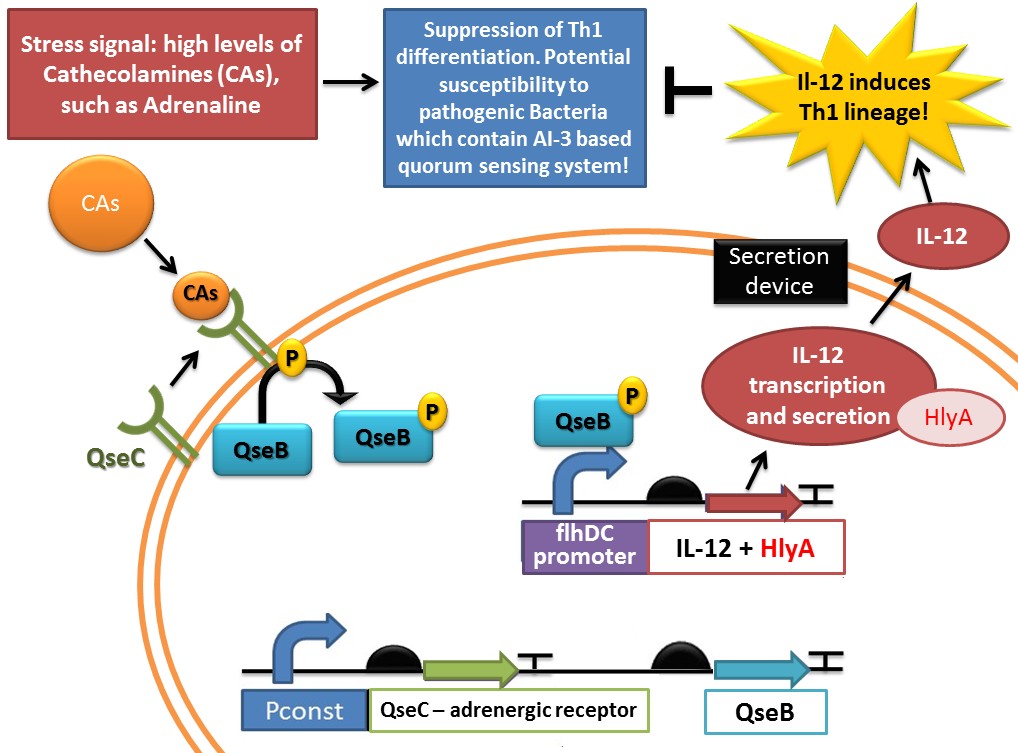Part:BBa_K554006
QseB and QseC
QseB and QseC are part of our Adrenaline, Norepinephrine and AI-3 sensor systems ([http://2011.igem.org/Team:UNICAMP-EMSE_Brazil/Project#Device_1:_Adrenaline_sensor.2FIL-12_producer CA sensor device/ IL-12 producer]). QseC is the bacterial adrenergic receptor which contains an histidine sensor kinase domain. This protein was recently discovered by Dr. Vanessa Sperandio laboratory (Sperandio et al., 2002), a researcher which created a real revolution in microbiology, demonstrating the existence of an interkingdon communication system, in which bacteria can sense host hormone levels (such as catecholamines) and respond by altering gene expression and multiplication (Sperandio et al, 2003). QseC binds to and increases its autophosphorylation in response to epinephrine, norepinephrine, and a bacterial signaling molecule termed autoinducer-3 (AI-3) (Clarke et al, 2006). The Response regulator for QseC is QseB (Clarke et al, 2006), and the genes encoding this two-component system are co-transcribed constituting an operon (Clarke et al, 2005). The QseC receptor may play a role in colonization or virulence with increased levels of epinephrine/norepinephrine and because of this, we choose this pathogenic system be used in the opposite function: to induce production of an immunoactivator interleukin (IL-12), to induce the immune system to avoid these bacteria to disseminate in gut and cause ilness in our stress conditions (situation in which we release high concentrations of adrenaline). We thus decided to create a completely new biobrick, responsible for sensing a stressfull condition or even a condition in which pathogenic bacteria are present in high ammount (and producing AI-3) and responding by Il-12 synthesis.
The QseC and QseB genes are used by [http://2011.igem.org/Team:UNICAMP-EMSE_Brazil UNICAMP-EMSE Brazil team] in the [http://2011.igem.org/Team:UNICAMP-EMSE_Brazil/Project#Device_1:_Adrenaline_sensor.2FIL-12_producer CA sensor device/ IL-12 producer] ("Device 1", which senses Catecholamine levels (such as Adrenaline, Norepinephrine and AI-3) and responds by producing and secreting IL-12).
Sequence and Features
- 10COMPATIBLE WITH RFC[10]
- 12COMPATIBLE WITH RFC[12]
- 21INCOMPATIBLE WITH RFC[21]Illegal BglII site found at 1635
- 23COMPATIBLE WITH RFC[23]
- 25COMPATIBLE WITH RFC[25]
- 1000COMPATIBLE WITH RFC[1000]
Usage and Biology
QseC and QseB are used by [http://2011.igem.org/Team:UNICAMP-EMSE_Brazil UNICAMP-EMSE Brazil team] in the [http://2011.igem.org/Team:UNICAMP-EMSE_Brazil/Project/Device1 Adrenaline sensor device] ("Device 1", which senses Cathecolamine and AI-3 levels and responds by producing and secreting IL-12. The QseC is essential to the functioning of this device, since it is responsible for the sensing the levels of CAs and AI-3, activation of the response regulator QseB, which is the transcription factor responsible for trancription of IL-12 fused construct gene, through binding to flhDC promoter, being the IL-12 synthesis trigger.
QseC gene and protein product are shown in green, and QseB gene and protein product are shown in blue in the following schema:
Three-dimensional structure representation
You can find below a tridimensional structure of cytoplasmic segment of histidine kinase receptor QseC (retrieved from PDB 3JZ3 (Xie et al. 2010)) solved by X-ray crystallography at 2.5 A resolution. This is a jmol applet, in which you can interactively see the protein structure of the QseC cytoplasmic domain:
References
- Clarke MB, Sperandio V (2005) Transcriptional regulation of flhDC by QseBC and sigma (FliA) in enterohaemorrhagic Escherichia coli. Mol Microbiol 57: 1734–1749. [http://www.ncbi.nlm.nih.gov/pubmed/16135237 Link to PubMed]
- Sperandio V, Torres AG, Jarvis B, Nataro JP, Kaper JB (2003) Bacteria-host communication: the language of hormones. Proc Natl Acad Sci USA 100: 8951–8956. [http://www.ncbi.nlm.nih.gov/pubmed/12847292 Link to PubMed]
- Sperandio V, Torres AG, Kaper JB (2002) Quorum sensing Escherichia coli regulators B and C (QseBC): a novel two-component regulatory system involved in the regulation of flagella and motility by quorum sensing in E. coli. Mol Microbiol 43: 809–821. [http://www.ncbi.nlm.nih.gov/pubmed/11929534 Link to PubMed]
- Clarke MB, Hughes DT, Zhu C, Boedeker EC, Sperandio V (2006) The QseC sensor kinase: a bacterial adrenergic receptor. Proc Natl Acad Sci U S A 103: 10420–10425
- Xie, W., Dickson, C., Kwiatkowski, W., Choe, S.Structure of the cytoplasmic segment of histidine kinase receptor QseC, a key player in bacterial virulence. Journal: (2010) Protein Pept.Lett. 17: 1383-1391 [http://www.ncbi.nlm.nih.gov/entrez/query.fcgi?cmd=Retrieve&db=PubMed&dopt=Abstract&list_uids=20594156 Link to PubMed]
| None |

